Всемирная военная энциклопедия
> США
> Нашивки
> Нарукавные нашивки Сухопутных войск
> Пехота
> US-INPTUS-00027

Нарукавный знак 34 пехотной дивизии СВ США
Случайные:

Нагрудный знак Республиканской гвардии Казахстана

Военная тюрьма "Кциот" Израиль

Нарукавный знак Вооруженных Сил Чеченской Республики Ичкерия
Редактировать или перевести информацию
Description
On a black olla with a 1/8 inch (.32 cm) black border, 2 inches (5.08 cm) in width and 2 1/4 inches (5.72 cm) in height, a red bull skull.
Symbolism
The patch shape simulates an olla (Mexican water flask) symbolizing the 34th Division’s origin, formation and intensive training site at Camp Cody, New Mexico in Oct 1917. The bull skull also symbolizes the surrounding dry, desert-like area. Black denotes durability, firmness and stability and red is for courage and action.
Background
The shoulder sleeve insignia was originally approved for the 34th Division on 28 June 1922. It was redesignated for the 34th Command Headquarters (Divisional), Iowa National Guard on 16 October 1963. The insignia was redesignated for the 34th Infantry Division effective 10 February 1991, and amended to add a border and provide a symbolism for the design. (TIOH Drawing Number A-1-99)
On a black olla with a 1/8 inch (.32 cm) black border, 2 inches (5.08 cm) in width and 2 1/4 inches (5.72 cm) in height, a red bull skull.
Symbolism
The patch shape simulates an olla (Mexican water flask) symbolizing the 34th Division’s origin, formation and intensive training site at Camp Cody, New Mexico in Oct 1917. The bull skull also symbolizes the surrounding dry, desert-like area. Black denotes durability, firmness and stability and red is for courage and action.
Background
The shoulder sleeve insignia was originally approved for the 34th Division on 28 June 1922. It was redesignated for the 34th Command Headquarters (Divisional), Iowa National Guard on 16 October 1963. The insignia was redesignated for the 34th Infantry Division effective 10 February 1991, and amended to add a border and provide a symbolism for the design. (TIOH Drawing Number A-1-99)
Еще из категории: Пехота
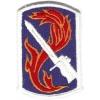 Нарукавный знак 198 пехотной бригады СВ США
Нарукавный знак 198 пехотной бригады СВ США
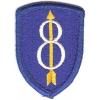 Нарукавный знак 8 пехотной дивизии СВ США
Нарукавный знак 8 пехотной дивизии СВ США
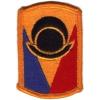 Нарукавный знак 53 пехотной бригады СВ США
Нарукавный знак 53 пехотной бригады СВ США
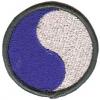 Нарукавный знак 29 пехотной дивизии СВ США
Нарукавный знак 29 пехотной дивизии СВ США
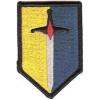 Нарукавный знак 1 бригады боевого обеспечения СВ США
Нарукавный знак 1 бригады боевого обеспечения СВ США



